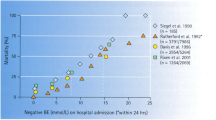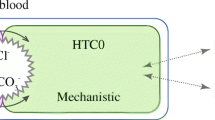Abstract
Blood [base excess] ([BE]) is defined as the change in [strong acid] or [strong base] needed to restore pH to normal at normal PCO2. Some believe that [BE] is unhelpful because [BE] may be elevated with a “normal” [strong ion difference] ([SID]), where a strong ion is one that is always dissociated in physiological solution, and where [SID] = [strong cations] — [strong anions]. Using a computer simulation, the hypothesis was tested that [SID] = [SID Excess] ([SIDEx]), where [SIDEx] is the change in [SID] needed to restore pH to normal at normal PCO2. The most current version of the plasma [SID] ([SID]p) equation was used as a template, and an [SIDEx] formula, of the Siggaard-Andersen form, derived: \({\left[ {{\text{SIDEx}}} \right]_p} = {\left[ {HC{O_3}^ - } \right]_P} - 24.72 + \left( {p{H_p} - 7.4} \right) \times \left( {1.159 \times {{\left[ {{\text{alb}}} \right]}_p} \times + 0.423 \times {{\left[ {Pi} \right]}_p}} \right)\). [SID] was compared to [SIDEx] over the physiologic range of plasma buffering, and it was found that [SIDEx] varied by ~ 15 mM at any given [SID], thereby faulting the hypothesis. It is concluded that [SID] can be “normal” with an elevated [SIDEx], the latter being an expression of the [BE] concept, and a more helpful quantity in physiology.
The “metabolic” componenet of a given acid-base disturbances is usually estimated as whole blood [base excess] ([BE]WB), where [BE]WB is defined as the change in [strong acid] or [strong base] need to restore plasma (pHp) to 7.4 at PCO2 of 40 Torr1–3. However. the [BE] approach has been criticized as “Inadequate for interpretation of complex acid-base derangements such as those seen in critically ill patient4–5.” The proposed alternative is the strong ion difference (SID) method, where a strong ion is one that is always dissociated in solution, and where [SID] = [strong cations - [strong anions]4–8.
On the one hand, it does not seem possible, by the definitions of these entities, to change [SID] without also changing [BE]. On the other hand, a selected group of critically ill patients with hypoproteinemia has been reported in whom [SID] was “normal” (i.e. ∼ 40mEq11) but [BE]WB clearly increased4,5,9. The idea was that hypoproteinemia caused the alkalosis, due to a deficiency of plasma weak acid buffer, necessitating increased [HCO3]p to maintain electrical neutrality. How could [SID] be “normal”, but [BE] increased? The purpose of the current exercise was to address this question. An [SID excess] ([SIDex]) formula was developed, conceptually identical to Siggaard-Andersen’s [BE], and [SID] was compared to [SIDex] over the physiological range of plasma [albumin] ([alb]p), plasma [phosphate] ([Pi]p), and plasma pH (pHp).
Access this chapter
Tax calculation will be finalised at checkout
Purchases are for personal use only
Preview
Unable to display preview. Download preview PDF.
Similar content being viewed by others
References
Siggaard-Andersen, O. The acid-base status of blood (Fourth Edition), Copenhagen, Munksgaard, 1974, pp. 80–83.
Siggaard-Andersen, O. The Van Slyke equation. Scand. J. Clin. Lab. Invest. 37; 15–20, Suppl. 146, 1977.
Siggaard-Andersen, O., Wimberley PD, Fogh-Andersen N, Gøthgen IH. Measured and derived quantities with modern pH and blood gas equipment: calculation algorithms with 54 equations. Scand. J. Clin. Lab. Invest. 48, Supp. 198, 7–15, 1988.
Fencl V, Leith DE. Stewart’s quantitative acid-base chemistry: applications in biology and medicine. Resp. Physiol. 91: 1–16, 1994.
Fencl V, Rossing TH. Acid-base disorders in critical care medicine. Ann. Rev. Med. 40: 17–29, 1989.
Stewart, P.A. How to Understand Acid-Base: A Quantitative Acid-Base Primer for Biology and Medicine. New York: Elsevier/North-Holland, 1981, Table 7.3.
Stewart, P.A. Modern quantitative acid-base chemistry. Can. J. Physiol. Pharmacol. 61: 1444–1461, 1983.
Figge, J., T. Mydosh, and V. Fencl. Serum proteins and acid-base equilibria: a follow-up. J. Lab. Clin. Med. 120:713–719, 1992.
McAuliffe JJ, Lind LJ, Leith DE, Fencl V. Hyproproteinemic alkalosis. Am. J. Med. 81: 86–90, 1986.
Rossing TH, Maffeo N, Fencl V. Acid-base effects of altering plasma protein concentration in human blood in vitro. J. Appl. Physiol. 61: 2260–2265, 1986
Courtney ME, Greene HL, Folk CC, Helinek GL, Dmitruk A. Rapidly declining serum albumin values in newly hospitalized patients: prevalence, severity, and contributory factors. JPEN 6: 143–145, 1982.
Sganga G, Siegel JH, Brown G, Coleman B, Wiles CE, Beizberg H, Wedel S. Reprioritization of hepatic plasma protein release in trauma and sepsis. Arch Surg 120: 187–199, 1985.
Schlichtig R. Base excess — a powerful clinical tool in the ICU. Critical Care State of the Art, Society of Critical Care Medicine, volume 17, 1996 (in press).
Author information
Authors and Affiliations
Editor information
Editors and Affiliations
Rights and permissions
Copyright information
© 1997 Springer Science+Business Media New York
About this chapter
Cite this chapter
Schlichtig, R. (1997). [Base Excess] vs [Strong ION Difference]. In: Nemoto, E.M., et al. Oxygen Transport to Tissue XVIII. Advances in Experimental Medicine and Biology, vol 411. Springer, Boston, MA. https://doi.org/10.1007/978-1-4615-5865-1_11
Download citation
DOI: https://doi.org/10.1007/978-1-4615-5865-1_11
Publisher Name: Springer, Boston, MA
Print ISBN: 978-1-4613-7689-7
Online ISBN: 978-1-4615-5865-1
eBook Packages: Springer Book Archive




